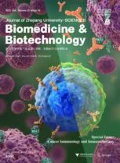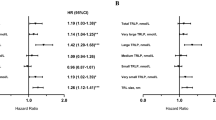Abstract
Objective
Disturbances in lipid and lipoprotein profiles in patients after kidney transplantation (Tx) are still not understood.
Methods
Serum levels of lipids, lipoprotein, triglyceride-rich lipoproteins (TRLs), and high-density lipoprotein (HDL) particles were determined, lipid and lipoprotein ratios were calculated, and their relationships in Tx patients with hypertriglyceridemia (HTG) and lower apolipoprotein AI (apoAI) concentration were examined. Serum lipid and lipoprotein levels were measured in 109 Tx patients and 89 healthy subjects. HDL particle levels were determined by enzyme-linked immunosorbent assay (ELISA).
Results
Tx patients had disturbed concentration, composition, and metabolism of TRLs and HDL particles. Multivariance analysis showed significant and positive correlation between HDL cholesterol/apoAI (HDL-C/apoAI) and HDL-C/HDL ratios, which indicates that both ratios could sensitively reflect changes in the HDL subclasses and their distribution into smaller size particles. In Tx patients, the decreased HDL-C/apoAI ratio indicates that, along with the decreased apoAI concentration, the HDL-C level is decreased. However, a low HDL-C/HDL ratio indicates that HDL particles in Tx patients transport lesser content of HDL-C but more triglyceride (TG) (high TG/HDL ratio), and thus are hypercatabolized and removed; therefore, concentration of HDL particles in serum was decreased.
Conclusion
The decrease of HDL-C/apoAI ratio seems to be a good marker of HDL subclass distribution into smaller size particles.
Similar content being viewed by others
References
Brinton, E.A., Eisenberg, S., Breslow, J.L., 1994. Human HDL cholesterol levels are determinate by apoA-I fractional catabolic rate, which correlates inversely with estimates of HDL particle size. Effects of gender, hepatic and lipoprotein lipases, triglyceride and insulin levels, and body fat distribution. Arteriosclerosis, Thrombosis, and Vascular Biology, 14(5):707–720.
Chan, D.C., Chen, M.M., Ooi, M.M., Watts, G.F., 2008. An ABC of apolipoprotein CIII: a clinically useful new cardiovascular risk factor? International Journal of Clinical Practice, 62(5):799–809. [doi:10.1111/j.1742-1241.2007.01678.x]
Contois, J.H., McNamara, J.R., Lammi-Keefe, C.J., Wilson, P.W., Massov, T., Schaefer, E.J., 1996. Reference intervals for apolipoprotein AI with a standardized commercial immunoturbidimetric assay: results from the Framingham Offspring Study. Clinical Chemistry, 42(4): 507–514.
Fellström, B., 2001. Risk factors for and management of post-transplantation cardiovascular disease. BioDrugs, 15(4):261–278. [doi:10.2165/00063030-200115040-00006]
Friedewald, W.T., Levy, R.I., Fredrickson, D.S., 1972. Estimation of the concentration of low-density lipoprotein cholesterol in plasma without the use of the preparative ultracentrifuge. Clinical Chemistry, 18(6):499–502.
Ghaznavi, R., Zahmatkesh, M., Kadhodaee, M., Mahdavi-Mazdeh, M., 2007. Cyclosporine effects on the antioxidant capacity of rat renal tissues. Transplantation Proceedings, 39(4):866–867. [doi:10.1016/j.transproceed. 2007.02.039]
Gou, L., Fu, M., Xu, Y., 2005. Alterations of HDL subclasses in endogenous hypertriglyceridemia. American Heart Journal, 150(5):1039–1045. [doi:10.1016/j.ahj.2005.02. 032]
Harchaoui, K.E.I., Arsenault, B.A., Franssen, R., Després, J.P., Hovingh, G.K., Stroes, E.S., Otvos, J.D., Wareham, N.J., Kastelein, J.J., Khaw, K.T., et al., 2009. High-density lipoprotein particle size and concentration and coronary risk. Annales of Internal Medicine, 150(2):84–93.
Jia, L., Long, S., Fu, M., Yan, B., Tian, Y., Xu, Y., Gou, L., 2006. Relationship between total cholesterol/high-density lipoprotein cholesterol ratio, triglyceride/high-density lipoprotein ratio, and high-density lipoprotein subclasses. Metabolism, 55(9):1141–1148. [doi:10.1016/j.metabol. 2006.04.004]
Jia, L., Wu, X., Fu, M., Xu, Y., Tian, Y., Tian, H., Tian, L., 2007. Relationship between apolipoproteins and the alteration of HDL subclasses in hyperlipidemic subjects. Clinica Chimica Acta, 383(1–2):65–72. [doi:10.1016/j.cca. 2007.04.017]
Kasiske, B.L., Chakkera, H.A., Roel, J., 2000. Explained and unexplained ischemic heart disease risk after renal transplantation. Journal of the American Society of Nephrology, 11(9):1735–1743.
Kasiske, B., Cosio, F.G., Beto, J., 2004. Clinical practice guidelines for managing dyslipidemias in kidney transplant patients: a report from the Managing Dyslipidemias in Chronic Kidney Disease Work Group of the National Kidney Foundation Kidney Disease Outcomes Quality Initiative. American Journal of Transplantation, 4(s7): 13–53. [doi:10.1111/j.1600-6135.2004.0355.x]
Kimak, E., Solski, J., Baranowicz-Gąszczyk, I., Książek, A., 2006a. A long-term study of dyslipidemia and dyslipoproteinemia in stable post-renal transplant patients. Renal Failure, 28(6):483–486. [doi:10.1080/08860220600778878]
Kimak, E., Książek, A., Solski, J., 2006b. Disturbed lipoprotein composition in non-dialyzed, hemodialysis, continuous ambulatory peritoneal dialysis and post-transplant patients with chronic renal failure. Clinical Chemistry and Laboratory Medicine, 44(1):64–69. [doi:10.1515/CCLM.2006.013]
Kimak, E., Książek, A., Baranowicz-Gąszczyk, I., Solski, J., 2007. Disturbed lipids, lipoproteins and triglyceride rich-lipoproteins as well as fasting and nonfasting non-high-density lipoprotein cholesterol in post-renal transplant patients. Renal Failure, 29(6):705–712. [doi:10.1080/08860220701460111]
Miyazaki, O., Fukamachi, I., Mori, A., Hashimoto, H., Kawashiri, M.A., Nohara, A., Noguchi, T., Inazu, A., Yamagishi, M., Mabuchi, H., et al., 2009. Formation of preβ1-HDL during lipolysis of triglyceride-rich lipoprotein. Biochemical and Biophysical Research Communications, 379(1):55–59. [doi:10.1016/j.bbrc.2008.11.146]
National Kidney Foundation, 2002. K/DOQI clinical practice guidelines for chronic kidney disease: evaluation, classification, and stratification. American Journal of Kidney Disease, 39(Suppl. 2):S1–S266.
Ooi, E.M.M., Hugh, P., Barrett, R., Chan, D.C., Watts, G.F., 2008. Apolipoprotein CIII: understanding an emerging cardiovascular risk factor. Clinical Science, 114(10): 611–624. [doi:10.1042/CS20070308]
Rashid, S., Barrett, P.H.R., Uffelman, K.D., Watanabe, T., Adeli, K., Lewis, G.F., 2002. Lipolytically modified triglyceride-enriched HDLs are rapidly cleared from the circulation. Arteriosclerosis, Thrombosis, and Vascular Biology, 22(3):483–491. [doi:10.1161/hq0302.105374]
Rubin, E.M., Ishida, B.Y., Clift, S.M., Kranss, R.M., 1991. Expression of human apolipoprotein AI in transgenic mice results in reduced plasma levels of murine apolipoprotein AI and appearance of two new high density lipoprotein size subclasses. PNAS, 88(2):434–438. [doi:10.1073/pnas.88.2.434]
Shivaswamy, V., Stevens, R.B., Zephier, R., Zephi, R.M., Sun, J., Groggel, G., Erickson, J., Larsen, J., 2008. Dyslipidemia can be controlled in diabetic as well as nondiabetic recipients after kidney transplant. Transplantation, 85(9): 1270–1276. [doi:10.1097/TP.0b013e31816de3F6]
Sui, W., Zou, H., Zou, G., Yan, Q., Chen, H., Che, W., Xie, S., 2008. Clinical study of the risk factors of insulin resistance and metabolic syndrome after kidney transplantation. Transplant Immunology, 20(1–2):95–98. [doi:10. 1016/j.trim.2008.07.003]
Tian, L., Wu, X., Fu, M., Qin, Y., Xu, Y., Jia, L., 2008. Relationship between plasma apolipoproteinB concentrations, apolipoproteinB/apolipoproteinA-I and HDL subclasses distribution. Clinica Chimica Acta, 388(1–2):148–155. [doi:10.1016/j.cca.2007.10.028]
Tian, L., Wu, J., Fu, M., Xu, Y., Jia, L., 2009. Relationship between apolipoprotein CIII concentrations and high-density lipoprotein subclass distribution. Metabolism, 58(5):668–674. [doi:10.1016/j.metabol.2009.01.007]
Tseng, K.H., 2006. Standards of medical care in diabetes-2006: response to the American diabetes. Diabetes Care, 29(11): 2563–2565. [doi:10.2337/dc06-0805]
Wang, L., Gill, R., Pedersen, T., Higgins, L.J., Newman, J.W., Rutledge, J.C., 2009. Triglyceride-rich lipoprotein lipolysis releases neutral and oxidized FFAs that induce endothelial cell inflammation. Journal of Lipid Research, 50(2):204–213. [doi:10.1194/jlr.M700505-JLR200]
Wissing, K.M., Abramowicz, D., Broders, N., Vereerstraeten, P., 2000. Hypercholesterolemia is associated with increased kidney graft loss caused by chronic rejection in male patients with previous acute rejection. Transplantation, 70(3):464–472. [doi:10.1097/00007890-200008150-00012]
Yang, Y., Yan, B., Fu, M., Xu, Y., Tian, Y., 2005. Relationship between plasma lipid concentrations and HDL subclasses. Clinica Chimica Acta, 354(1–2):49–58. [doi:10.1016/j.cccn.2004.11.015]
Author information
Authors and Affiliations
Corresponding author
Additional information
Project (Nos. PW 55/09 and DS 41/09) supported by the Department of Laboratory Diagnostics, Medical University of Lublin, Poland
Rights and permissions
About this article
Cite this article
Kimak, E., Hałabiś, M. & Baranowicz-Gąszczyk, I. Relationships between serum lipid, lipoprotein, triglyceride-rich lipoprotein, and high-density lipoprotein particle concentrations in post-renal transplant patients. J. Zhejiang Univ. Sci. B 11, 249–257 (2010). https://doi.org/10.1631/jzus.B1000012
Received:
Accepted:
Published:
Issue Date:
DOI: https://doi.org/10.1631/jzus.B1000012




